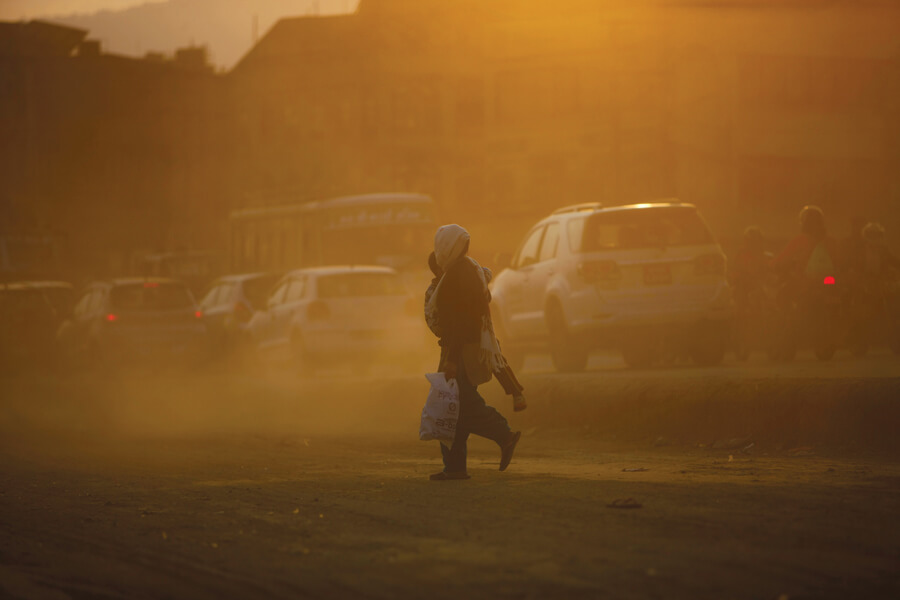Dirty Kathmandu air gets dirtier

Kathmandu’s air quality has just got considerably worse, not just because of dirtier air, but because the World Health Organisation (WHO) has revised its Global Air Quality Guidelines, halving the recommended value for annual average pollution levels.
Safe exposure to concentrations of harmful particles below 2.5 microns (PM2.5) in diameter every year has now been halved, meaning that many Kathmandu residents could be breathing much more polluted air than they throught.
On 22 September the WHO updated its Air Quality Guidelines (AQG) such that annual mean concentrations of PM2 should not exceed 5 kg/m3 and NO2 not exceed 10 kg/m3. In addition, peak season mean 8-hr ozone concentration should not exceed 60 kg/m3.
The 2005 guideline values for PM2 and NO2 were, 10kg/m3 and 40 kg/m3 respectively, with no recommendation for long-term suspended particles and ozone concentrations.
Environmentalist Bhushan Tuladhar immediately took to twitter to respond to the new recommended standard for air quality: ‘The WHO just released its new air quality guidelines which have halved the guideline value for annual average PM2.5 in ambient air. This means Kathmandu, which had annual PM2.5 levels that were about five times higher than the WHO guidelines now have pollution levels that are 10 fold higher.’
The new standards are ambitious and reflect the large impact of air pollution on public health, and experts hope that it will influence air quality policy across the globe. They recommend bold action to clean up the air at all levels and across all sectors such as transport, energy, industry, agriculture and residential.
“Air pollution is a major global public health threat that causes a range of adverse health effects, even at the lowest observable concentrations. The updated guidelines offer a wake-up call, to reconsider current air quality legislation and regulations,” noted a joint statement released by the International Society for Environmental Epidemiology (ISEE) with the European Respiratory Society following the revised guidelines.
It adds: “There is ample evidence to strongly support government action to reduce air pollution and address climate change simultaneously. But the most important message is that each reduction in the outdoor concentrations of key air pollutants brings health benefits to the surrounding population, even in places which already have low pollution concentrations.”
Additionally, most jurisdictions with clean air regulations have relied on fixed limit values with little incentive to further reduce air pollution levels once compliance with the limit value is achieved. Given the evidence that health effects occur down to very low concentration levels, future clean air policies must include incentives for progressive lowering of exposures of the entire population, thereby improving health for all.
The new air quality guidelines are not legally binding however but experts believe can represent a turning point in the way we approach air pollution globally, and in particular, South Asia where the air pollution levels are consistently high and the health burden is stark.
“The new guidelines offer a benchmark for South Asian cities and countries to plan their air quality agenda. This will bring renewed interest in the topic and create an opportunity to push for stronger action,” says Pallavi Pant of Health Effects Institute based in Boston.
She adds: “We know where we’d like to get to, and the real discussion now should be focused on the basket of strategies and sectors we need to address.”
Air pollution, indoors and outdoors, accounted for some 12% of all death in 2019. Air pollution currently ranks fourth among major risk factors for global disease and mortality, only behind hypertension, smoking and dietary factors.
In terms of economic burden, the estimated global health-related external costs were $5 trillion in 2013 with an additional $225 billion in lost labour productivity as per the World Bank Group 2016.
Here in Nepal, the new guidelines hardly made it to the news. Nepal doesn’t even have a minister for the environment because of a continued political stalemate.
Successive governments in the recent past have made commitments to promote electric vehicles and transport for clean air, but they have done the opposite. Earlier this year in the budget, it reintroduced tax rebates. But only this week, Prime Minister Sher Bahadur Deuba’s government slashed taxes on the import of 10 or more diesel buses by new luxury hotels to 1%. It also cut by half the duty on petrol motorcycle assembly in Nepal.
The Covid-19 pandemic and subsequent lockdowns over the last two years have shown people that the goal of clean air can be achieved, and it has become even more crucial at this point where the coronavirus cases are going down, vaccinations have picked up and businesses are reopening for the Dasain-Tihar festive season.
“There is no shortcut to clean air, we need long-term policies that target major sources including transportation, use of wood/animal dung for cooking and heating, brick kilns, coal power plants, industries and waste burning,” adds Pant ,who is from India.
She adds: “Access to clean energy for all is one key policy that can help reduce the burden of air pollution. It is also useful to keep in mind that air pollution is a multi-sectoral problem, and we must engage not just technical experts but also legal and policy experts, economists, healthcare workers and others in developing solutions.
In the short term, especially as we approach the winter season, the government should ensure the public that air quality data is accessible and understandable. With this information, the public can avoid outdoor activities during hours when the pollution is at its peak and reduce the prevalence of allergies and immediate respiratory illness.




